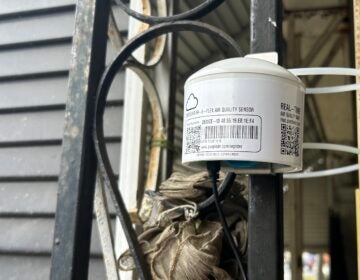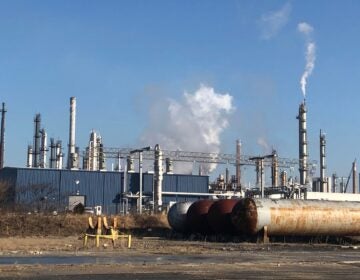Delaware City residents seek accountability from Delaware City Refinery, regulators
June 16, 2025
This story is part of the WHYY News Climate Desk, bringing you news and solutions for our changing region.
From the Poconos to the Jersey Shore to the mouth of the Delaware Bay, what do you want to know about climate change? What would you like us to cover? Get in touch.
When a mechanical failure caused toxic air pollutants to emit from the Delaware City Refinery for almost three weeks, nearby residents expressed their frustration. The refinery, located in New Castle County, has violated their permit on multiple occasions.
“I’d like to see somebody stand up to the oil company and say, ‘If you can’t operate this plant safely, move to Texas — but in Delaware, you must meet a standard,’” said Steven Michael, who lives three miles from the refinery.
The Delaware Department of Natural Resources and Environmental Control is investigating the incident, which officials say will likely lead to a violation. The agency assured nearby residents there was no public health threat, and the failed equipment was repaired last week.
Still, residents say the latest incident was the last straw. They are now calling for tougher environmental laws, and want regulators to evaluate what could have been done differently.
“There’s a lot of things about Delaware that I love,” Michael said. “I don’t love living next to a refinery that is allowed to continue to pollute.”
A mechanical failure at the Delaware City Refinery compromised an emission control device, causing releases of sulfur dioxide above permitted levels for two and a half weeks.
The refinery, owned by PBF Energy, reported daily emissions of the toxic gas at rates as high as 1,450 pounds per hour since first reporting the incident May 25. Since repairing the equipment, the refinery’s scrubber has performed in compliance.
Concerned citizens had called on the refinery to shut down operations while the equipment was being fixed. However, DNREC officials said the complicated process of closing the refinery would run the risk of releasing more pollutants.
DNREC said air quality monitoring indicated the pollution did not impact air quality, and therefore did not pose a public health threat. Officials said monitoring stations downwind of the facility — between the refinery and nearby homes — accurately measured air quality.
However, several environmental experts interviewed by WHYY News’ Climate Desk said the reliability of the state’s monitoring stations depend heavily on wind direction and weather.
“Those tools can be compromised based on the wind direction. They can have some issues based on time of day, heat, as well as how often they’re maintained,” said Joseph Wilkins, professor of earth, environment and equity at Howard University. “If the plume from the stack doesn’t hit exactly where the monitor is placed, it’s not going to register anything.”
Angela Marconi, division director for air quality at DNREC, said though the monitoring station in Delaware City does not utilize meteorological equipment, the agency relied on other weather-related data.
“It’s meaningful no matter what the wind direction is because we have a mission to monitor the air quality and know what the air quality is,” Marconi said. “It is in the primary direction of the prevailing wind, so it does serve that purpose most of the time.”
Wilkins said there are a number of tools DNREC could use to get a better picture of the impacts. Lidar detection, which stands for Light Detection and Ranging, can scan the air vertically from any location.
Residents also voiced concerns about the cumulative effects of the emissions, particularly for vulnerable populations like those with respiratory health problems. At high levels, sulfur dioxide can cause breathing difficulties.
More than 86,000 people live within a 5-mile radius of the refinery, more than half of whom are people of color, and 20% live in low-income households, according to U.S. Environmental Protection Agency data.
According to the state’s air quality monitoring data, sulfur dioxide was detected at levels far below EPA standards, indicating the air was safe even for people with asthma. However, toxicologist Dr. Marilyn Howarth, of the University of Pennsylvania, has concerns.
“Is that monitor modeling for the people who live immediately around it? Yes, I think it is. I think those people can feel comfortable,” she said. “But I don’t know about all of the other people, because of the way the air is moving, and it may be that there are other neighborhoods that this monitoring number is really underrepresented for.”
History of violations
Though DNREC said an investigation will likely lead to a violation, residents have questioned whether state environmental regulators have done enough to make the refinery accountable for its actions.
The refinery has a history of violations, including for sulfur dioxide releases, which residents argue have not compelled the facility to make improvements. The refinery has received more than 50 violations in the past 10 years, most recently, for carbon monoxide emissions.
The refinery has historically been one of the region’s top polluters — releasing more than 4.6 million pounds of pollutants in the air and water in 2023, according to EPA data. According to the National Emissions Inventory, the refinery released more than 430,000 pounds of sulfur dioxide in 2020.
However, a spokesperson for the refinery said that since PBF acquired the facility from Valero Energy in 2010, there has been about an 83% reduction in sulfur dioxide emissions since 2022 compared to the last three years that Valero owned and operated it.
Environmental groups have criticized DNREC, accusing them of not enforcing violations. In 2019, the Delaware City Refinery had piled up years of unpaid fines and ultimately paid DNREC $950,000 to resolve the backlog.
“The industry is being left to set their own timetable, to take whatever time they need, to not suffer any economic consequences,” said Miriam Rotkin-Ellman, a public health scientist and technical advisor for the advocacy group Environmental Justice Health Alliance, adding that regulators “don’t have any pressure put on them, that I can tell, to get this fixed. And the result is that communities are potentially choked with the pollution.”
Marconi of DNREC argues the agency issues violations each time a facility violates its permit.
“We enforce all of the requirements that are on the books for the refinery,” she said. “Everything that the refinery is required to do, we require them to do it.”
The level of penalty can be determined based on the severity of the incident and whether a facility has repeat violations. However, regulators cannot penalize facilities above what the law allows.
Democratic state Rep. Larry Lambert, who represents Claymont, has introduced legislation that aims to hold chronic polluters accountable. HB 210 would increase pollution fines — one of which had not been raised since 1973 — by as much as $30,000.
The legislation also aims to give DNREC more power to enforce violations, allowing the agency to appeal decisions by the Environmental Appeals Board relating to chronic violator status.
“We want to make sure that all Delawareans have access to pollution-free air, pollution- free water and pollution-free soil, but we can’t get there without accountability,” Lambert said.
Gov. Matt Meyer’s office did not respond to a request for comment.
Environmentalists say more could be done to prevent pollution in the first place. The Delaware City Refinery has not conducted on-site or fence-line monitoring for sulfur dioxide, nor does its license require them to do so. Local politicians such as New Castle County Councilman Kevin Caneco are calling for legislation to change that.
Howarth said going forward, there should be air quality monitors in all four directions around the facility utilized at all times.
“This is an old refinery, and accidental releases are more common in old refineries,” she said. “The other point is, when you do have one of these events, it is not adequately protective of the public to rely on your one monitor that happens to not be in the place where you’d expect it to pick up the worst-case scenario.”
The refinery did not respond to a request for comment about future monitoring. However, during a June 5 interview, general manager Michael Capone said the facility conducts a root-cause analysis any time an accident occurs.
“We have a full department that is devoted to mechanical integrity, ensuring that the equipment doesn’t have failures and reliability, ensuring that equipment doesn’t break down. That department reports up to a department head who reports directly to me,” he said.
Capone also promised to improve communication with nearby residents in the future about refinery operations and any potential impact on the community.
In the meantime, Wilkins of Howard University advises residents who live near the refinery to purchase a certified high efficiency particulate air filter.

Get daily updates from WHYY News!
WHYY is your source for fact-based, in-depth journalism and information. As a nonprofit organization, we rely on financial support from readers like you. Please give today.
Search
RECENT PRESS RELEASES
Related Post








